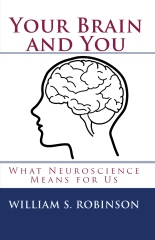At last month’s “Toward a Science of Consciousness” conference in Tucson, Pomona College researcher Eve Isham reported on several studies under the title “Saving Free Will From Science”. These studies cast doubt on conclusions that are often drawn from a series of famous studies carried out by Benjamin Libet.
Participants in Libet’s experiments wore a device on their head that measures electrical activity at points under the scalp. They were instructed to make a small movement (e.g., a flick of the wrist) whenever they felt like doing so. They watched a clock-like device, in which a dot rotates around the edge of a circle at the rate of two and a half times per second. There are marks and numbers around the edge of the circle. Their task was not only to make a movement when they felt like it; they were also to take note of where the dot was when they (a) formed the intention to make their movement, and (b) when they actually moved. They were asked to report these two times right after they made their movement.
Let’s call these times Int and Mov. What Libet found was that participants’ electrical activity showed a telltale rise a short time (roughly, a half second) before the reported time Int. This telltale marker is called a “readiness potential”, usually abbreviated as RP. (There are complicated corrections that must be made for the time it takes for signals to travel along neurons; the interval between RP and Int is what remains after these corrections have been taken into account.)
The key points are that RP comes before Int, and that Int is the moment when the intention to move first becomes conscious. The conclusion that many have drawn is that the process that is going to result in a movement starts unconsciously before a person becomes aware of an intention to move. So, the intention comes too late to be the real cause of the movement. But if people’s intentions to move are not the real causes of their movements, then they don’t have free will.
(Libet tried to avoid this conclusion by holding that there was enough time for a person to insert a “veto” and stop the movement. This has earned him a quip: he undercuts free will, but allows for free won’t. Few have found this view attractive.)
Critics of Libet’s work have raised many questions about the experimental design, and I have long regarded these experiments as resting on assumptions that seem difficult to pin down with sufficient accuracy. Isham’s presentation significantly deepened these doubts.
Although I have read many papers on Libet’s work, I had never seen the clock in motion. Isham showed a video, and as I watched, I imagined myself as a participant in Libet’s experiments. I flicked my wrist a few times, and thought of what I would have reported as the times of my intention to move, and my actual movement.
I found that it was extremely difficult to try to estimate two times. In fact, I found it hopeless, and soon gave up, settling for focusing on trying to get an accurate estimate of the time of my intention to move.
But even this simpler task was difficult, and I had no sense of confidence that I could locate the time of my intention more accurately than about an eighth of a revolution (that’s the distance of about eight minutes around the circumference of a regular clock face). When trying to do the task, the dot seemed to be moving very fast.
It’s natural to wonder whether accuracy might be improved by using a clock where the dot was not traveling so fast. That’s one of the variations on Libet’s set up that Isham tried. And here is the decisive result: When she did that, the estimates of the time of intention were earlier. RP was still a little bit earlier than the reported Int time, but the interval was very significantly reduced.
Isham reported several other variations on Libet’s design, all of which lead to the same general result: the estimates of Int depend on clock speed and several other factors that shouldn’t make a difference, but do. These results offer strong support for her conclusion that the time of intention is not consciously accessible to us, and we cannot use Libet-style experiments to undercut the view that our intentions cause our actions.
Readers of Your Brain and You, or some other posts on this blog, may recall that I am sympathetic to the conclusions that are often drawn from Libet’s work. So, I don’t think Isham has saved free will from science. But her work gives us more reason than we have previously had for not basing anti-free-will conclusions on Libet-style investigations.
[The abstract of Isham’s conference paper is available here.]



 Posted by wsrob
Posted by wsrob 